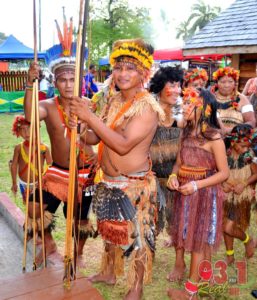By Chevon Lim
The Konashen Amerindian District contains one community populated primarily by the Wai- Wai people. Masekenari, which means “mosquito place” in the Wai- wai language, was established in 2000 when flooding forced the community to move from its previous location at Akotopono 6 km north – east of the present community of Masekenari. The village has approximately 224 residents .The Wai- wai people have a rich culture and history and continue to maintain their cultural heritage and practices.
The Konashen Amerindian district is also known as the “Community Owned Conservation Area (COCA). The Wai- Wai people have absolute title to their land and have an elected Village Council. The community is equipped with a Primary School, COCA office/ Village Office, Church buildings, Teachers Quarters, Health post Community benab, rest house, and women’s training centre, and a Village kitchen.
In 2007, during the second Latin American Parks Congress, the Wai Wai peoples of Guyana declared their land a “Community Owned Conservation Area” The tribe has banned mining and logging from their land in the tropical forest in remote southern Guyana near the Brazil border. They have pledged to pursue a sustainable economic strategy based on eco-tourism, research and traditional crafts. The paramount aim of the people is the preservation of their culture.
The Amerindian population of Guyana consists of nine major ethnic groups, including the Akawaios, Arawaks, Arekunas, Caribs, Makushis, Patamonas, Wapishanas, Warraus and the Wai-Wais. The Wai Wais are mainly found in the hinterland or the interior region. They are the smallest indigenous grouping in Guyana .
The explorer, Sir Robert Schomburgk, may have been the first non- Indian to have contact with the Wai-Wai in December 1837. He found one village on a tributary of the Essequibo River, along with two others on the Mapuera River in Brazil. Schomburgk describes the Wai-Wai as:

“Of medium height, their skin lighter than that of Tarumas, in their general appearance and language they resemble the Makuskis a good deal…”
During the early 20th century, some of the Wai Wai in Brazil moved further north. It is speculated that this is because of the influenza epidemic that nearly exterminated the Taruma tribe. From 1933 to 1938, the Wai Wai people moved deeper in Guyana’s interior. The villagers also have access to the internet allowing them to set up a hub, which is equipped with computers and which will assist them to manage their community. Other ICT developments in Masekenari include the installation of a Band VSAT system with Wi-Fi capability. The new system has unlimited capacity and ‘No data cap’ usage. It can also withstand severe weather conditions, and it allows the residents to communicate with anyone at any time, whether in drought or flood. It will provide the Masekenari residents with a fast path to modern healthcare, education, and security.(Guyana Times Sunday Magazine)



